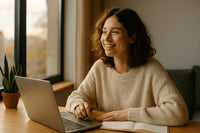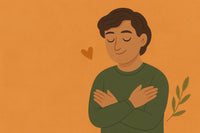What is the Intersection of Gay Art & Autism?

Written by the HeyASD Editorial Team
Have you ever pondered the fascinating crossroads of gay art and autism? It might seem like an unlikely intersection, but it's a place bursting with color, emotion, and above all, humanity. This nexus provides an intriguing lens through which to view these two distinct yet interconnected communities where stories and life experience often intertwine. Shall we take a closer look?
The Gay Art Movement
A Brief History
The history of gay art can be traced back to the dawn of civilization, with traces of homoerotic themes in Greek and Roman antiquity. Yet, it was not until the 20th century, with the rise of the gay rights movement, that art began to play a key role in expressing LGBTQ+ identity, rights, and experiences.
The Significance of Gay Art
Gay art has long served as a powerful tool for advocating for rights and acceptance, articulating identity, and challenging societal norms. It gives voice to the silenced and allows marginalized individuals to share their unique experiences, feelings, and dreams with the world. Think of it as an invitation to see the world through their eyes.

Autism and Art
The Therapeutic Role of Art in Autism
In the autism community, art is more than just an aesthetic pursuit. It's a means of communication, expression, and therapy. Art therapy can assist autistic individuals in expressing emotions they may find difficult to verbalize. In essence, their artworks become a tangible expression of their inner world.
Notable Artists with Autism
Autism does not hinder creativity. Quite the opposite - it can often amplify it. Stephen Wiltshire, Donna Williams, and Temple Grandin are just a few among many artists who have used their autism as a conduit for their creativity, proving that their condition is not a barrier to artistic success.

Where Gay Art and Autism Intersect
Personal Expression and Identity
In the overlap between gay art and autism, we find a realm where personal expression and identity take center stage. For a gay artist with autism, their art can serve as a dual-purpose platform: one that allows them to express their sexuality while also communicating their unique perspective as an autistic individual.
Breaking Barriers
At this intersection, art is more than a platform for expression; it's a tool for breaking down barriers. Artists who are both gay and autistic use their work to challenge societal expectations and stereotypes about both communities, inspiring change and fostering understanding.
Prominent Gay Artists with Autism
Artist Profiles
Although they are often overlooked, there are several noteworthy artists who identify as both gay and autistic. Their work explores themes of identity, sexuality, and neurodiversity, painting a vivid picture of their lived experiences. These artists use their unique perspectives to create art that pushes boundaries, sparks conversations, and promotes acceptance.

The Impact of Their Work
Raising Awareness
By sharing their experiences, these artists help to raise awareness about both the gay and autistic communities. Their art serves as a powerful reminder that being different is not a defect, but a beautiful divergence.
Changing Perceptions
Through their art, they not only give a voice to marginalized communities, but they also change perceptions, dismantle prejudices, and challenge the status quo. In doing so, they shine a light on the rich tapestry of human diversity and experience.
Join Hundreds of Autistic Adults Feeling
More Comfort in Their Own Skin
Use code WELCOME10 for 10% off your first order.
Start Your Comfort JourneyConclusion
In the end, the intersection of gay art and autism serves as a testament to the power of art as a tool for expression, communication, and social change. It underscores the important role art plays in empowering marginalized communities and fostering understanding among different identities. In this intersection, we find not only remarkable art but also lessons in acceptance, empathy, and the strength of the human spirit.
FAQs
1. What is gay art? Gay art refers to artworks that portray homosexuality or are produced by gay artists. It's a broad genre that includes a variety of mediums and styles, unified by the shared theme of LGBTQ+ identity and experiences.
2. How does art benefit individuals with autism? Art can be therapeutic for individuals with autism, helping them to express emotions they may find challenging to verbalize. It also fosters creativity, improves motor skills, and provides a sense of accomplishment.
3. Who are some notable gay artists with autism? While many may choose to keep their identities private, there are artists in this intersection who have publicly shared their stories. Their identities are as diverse as their artistic styles, reflecting a broad range of experiences and perspectives.
4. How does the work of gay artists with autism impact society? Their work raises awareness about both the gay and autistic communities. By sharing their unique perspectives and experiences, they challenge stereotypes, promote acceptance, and inspire change.
5. Can art influence perceptions of marginalized communities? Absolutely. Art can be a powerful tool to challenge societal norms, highlight diversity, and foster understanding and acceptance of marginalized communities.





















